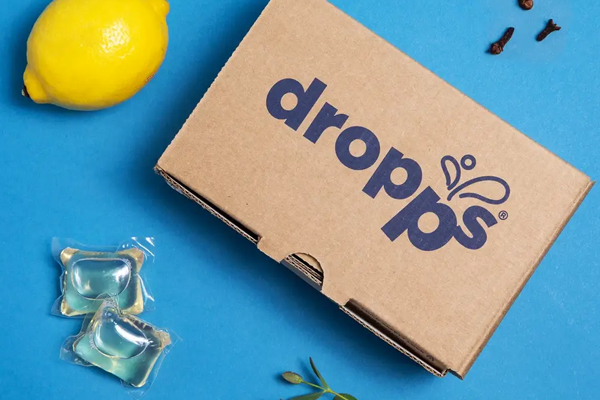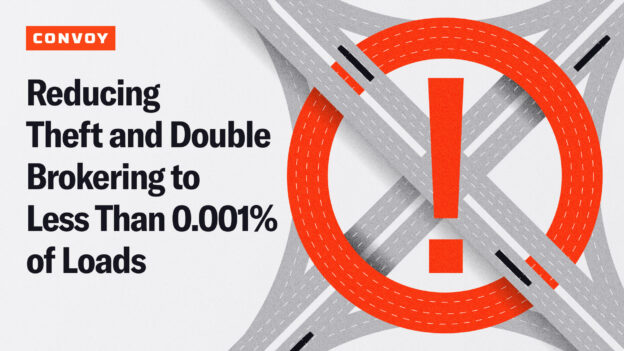Dropps tests limits of a lean, clean supply chain
Sustainability, Tech & Visibility
The client:

The challenge:
Sustainability is integral to Dropps’ business decisions—from product formulation and development to marketing. But to build a supply chain with a footprint as light and efficient as its detergent pods would require a new freight partner.
The outcome:
By tapping into Convoy’s pooled truckload capacity and shipment insights, Dropps could optimize routes and easily track and control carbon emissions.
Convoy solutions:
- FTL Shipping
- Online shipper platform
- Load batching
Dropps is a familiar success story in the new wave of direct-to-consumer subscription business models: The sensible packaging and elegant design of the laundry and dish detergent pods are unmistakable. And while Dropps’ commitment to environmentally friendly detergent formulas and eco-responsible packaging is a well-known part of the company’s story, the transformation of Dropps’ supply chain is less understood.

The company’s iconic product — it invented the detergent pod — has its origins in the 1980s at the textile mills owned by Dropps founder Jonathan Propper’s family. The existing detergents at the time were too harsh for natural fibers; by removing some enzymes, they created a low-suds detergent that was effective against dirt but didn’t damage the fabric. The formula was marketed as Cot’n Wash in the 1980s; later, when Jonathan secured the formula, he started Dropps with a simple, dissolvable pod that removed the mess and waste and detergent packaging.
Dropps originally had a brick-and-mortar retail strategy where it competed for shopper attention and shelf space alongside neon-colored competitors like Tide. Dropps had a third-party fulfillment center that shipped inventory to sit inside big-box stores and used a complex network of distributors that wasn’t necessarily efficient or the most cost-effective.
But the company decided to make a major shift to a direct-to-consumer (DTC) model when it realized that by removing all of the extra water from the formula, it had already created a smaller, lighter product that could be shipped to customers with lower emissions compared to heavier products. Dropps established its own warehouse and fulfillment center in the Chicago area, centrally located in its supplier network, and ships to the entire country from there.
Cauvery Patel, Dropps’ chief operating officer, said the move to DTC enabled Dropps to lean into its mission to reduce single-use plastic even further.
“Shipping direct to consumers necessitated eliminating a lot of stupid stuff that goes along with brick-and-mortar product development,” Patel said. “We’re making the detergents as concentrated as possible, using as little material as possible and not shipping air. The more concentrated and smaller the product, the more you can fit in a specific box, and the more you can transport in a singular truck compared to the alternatives. A normal Tide pod is 25 grams; our pod with the same cleaning capacity is 9 grams, which gives us tremendous advantages in lowering emissions in our supply chain.”
Single-use plastic has been reduced from the packaging by offering a compostable and recyclable cardboard package that doubles as the shipping container, and Dropps is transitioning to printing labeling directly on its cardboard boxes to further reduce packaging.
Sustainability drives all the decisions we make, from product formulation and development to marketing, and supply chain is a huge opportunity.”
Cauvery Patel, chief operating officer at Dropps
The Chicago fulfillment center is well situated between suppliers in Wisconsin, Illinois and Kentucky — companies that manufacture the liquid detergent itself or make boxes for Dropps to ship its pods.
Dropps chose Convoy to manage its full truckload freight network because of a shared vision around supply chain sustainability. Convoy helps its customers easily track and control carbon emissions from transportation, and it pools capacity to more efficiently utilize assets.
The shape of Dropps’ network means that its headhaul lanes are often backhaul lanes for other shippers, allowing Convoy to find available capacity easily and reduce the number of empty miles in the trucking industry. Convoy’s batching capabilities for carriers is suited for that specific use case: It allows carriers to book multiple jobs at the same time to complete a circuit with maximum asset utilization and minimal empty miles. In practice, that means having a guaranteed loaded return trip or “backhaul” for each headhaul load a carrier takes from Convoy.
Over the past two years, we’ve been able to significantly increase the frequency of our production runs. Because of that, we’ve never had a situation where we’ve needed dedicated trucking capacity, but now we’re at a stage where we want more control and flexibility in our supply chain, especially as it relates to sustainability. Now we own all of the emissions. With Convoy, we can grab the capacity as needed knowing that it’s part of a larger, efficient ecosystem.”
Cauvery Patel, chief operating officer at Dropps
Convoy pools its customers’ private fleet capacity as well, creating a shipper network that can be optimized on a scale larger than individual companies. Machine learning models identify how those networks overlap and link up, and attacks mismatches so that one company’s empty private fleet truck might be filled with another company’s freight. That generates revenue and improves asset utilization for the private fleet while reducing costs and carbon emissions for the second company.
“The whole premise of our brand philosophy is about no waste, so choosing Convoy was a super-logical application of this principle to the supply chain,” said Elena Lécué, chief marketing and revenue officer at Dropps. “The two core things we’re trying to do with our emissions is reduce and offset. We can use mechanisms like carbon offsets or energy certificates to offset our emissions, but Convoy allows us to insert an element of reduction, as well.”
Dropps plans to conduct an audit of all its fulfillment center’s internal processes and develop a “pull” model rather than a “push” model. In a “pull” model, a highly responsive supply chain reacts quickly to customer demand signals to manufacture and ship product as needed, rather than “pushing” inventory down a supply chain and then figuring out how to sell it at a downstream retail location.
The company’s vision is to build a supply chain with a footprint as light and efficient as its detergent pods. By taking control of distribution, stripping out extraneous packaging, and tapping into Convoy’s pooled truckload capacity, Dropps is well on its way.



